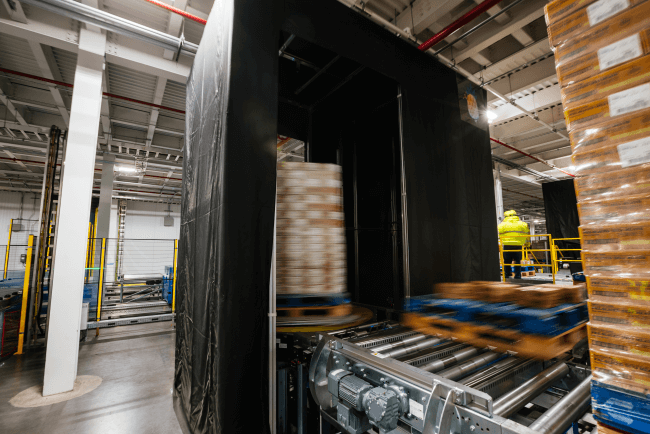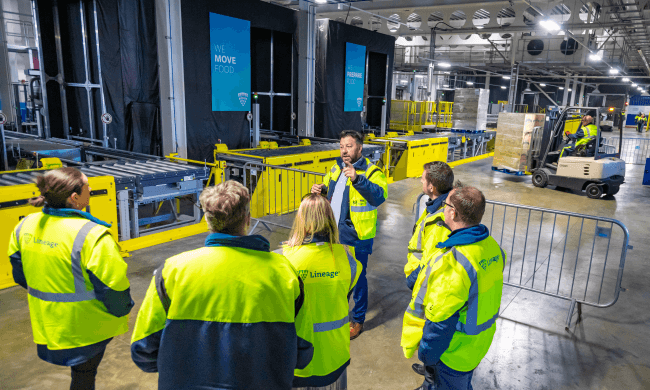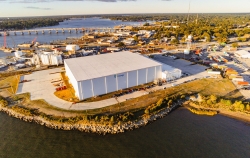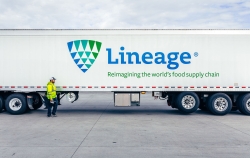An Eye for the Future: How Lineage's Data Science Team is Transforming the Cold Chain
February 17, 2025
At Lineage, innovation doesn’t happen in a vacuum. It’s the product of a forward-looking philosophy driven by a cutting-edge team with an ownership mentality. Lineage's Data Science team works hand-in-hand with our in-house technology product teams, network operations and team members across our warehouse operations and functional teams to create comprehensive solutions that work.
One example of this process was the development of Lineage Eye, a technology that automates how pallets are received in select Lineage warehouses. Lineage Eye uses cameras and computer vision, a type of visual artificial intelligence, to identify what’s on a pallet in a matter of seconds, helping warehouses receive products faster while reducing mistakes.
Brian Leahy, Staff Data Scientist at Lineage, has been at the heart of this project since joining in 2021. We sat down with Brian to discuss the challenges, innovations and impact of developing Lineage Eye.
Learn how Lineage Eye is automating receiving
With Lineage Eye’s computer vision technology, Lineage is reimagining pallet receiving.
Q: Tell us about your role at Lineage and how you became involved with the development of Lineage Eye.
Brian Leahy: After finishing my PhD and post doctorate, I wanted to take on a new challenge that would help make the world a better place, with more immediate real-world impacts. I joined Lineage’s Data Science team in July 2021, specifically to work on Lineage Eye and bring computer vision technology to the company. From day one, this project was my main focus—both in terms of development and ensuring its success in real-world operations.
Q: What problems does Lineage Eye aim to solve?
 Brian: One major solution is around efficiency with our labor. Dock management, especially at automated facilities is essential to keep things running smooth in the warehouse. Lineage Eye streamlines receiving by automating a process that can typically take minutes, completing it in just seconds. Automating receiving speeds up the flow of products into the warehouse and frees our team members up to focus on other essential tasks in the warehouse, like monitoring product quality, maintenance and order picking.
Brian: One major solution is around efficiency with our labor. Dock management, especially at automated facilities is essential to keep things running smooth in the warehouse. Lineage Eye streamlines receiving by automating a process that can typically take minutes, completing it in just seconds. Automating receiving speeds up the flow of products into the warehouse and frees our team members up to focus on other essential tasks in the warehouse, like monitoring product quality, maintenance and order picking.
Accuracy was another big issue. Mistakes in receiving can have a big impact and cascade through the supply chain, leading to even bigger problems later. If a pallet is received incorrectly, the wrong product could be shipped or misplaced in the warehouse, resulting in delays, returns or even food waste if perishable items expire. Lineage Eye makes fewer mistakes than humans and can help us catch errors earlier, helping prevent costly mistakes and improve the flow of goods through the supply chain.
Q: What led your team to take ownership of the Lineage Eye project?
Brian: We were given the broad challenge of "automate receiving." I love open-ended directives because they force you to think holistically. We had to consider the entire workflow, from hardware, to software, to user experience, to long-term maintenance.
It also meant working closely with the people actually using the system. I spent a lot of time talking to warehouse operators, general managers and on-site teams to understand what they really needed. That collaboration was key.
Q: How did collaboration with the operations team help in developing and improving Lineage Eye?
 Brian: It was huge. Many of our best improvements came directly from conversations with team members on the floor. They helped us expand Lineage Eye’s capabilities in ways we never would have considered if we had just built the system in a silo.
Brian: It was huge. Many of our best improvements came directly from conversations with team members on the floor. They helped us expand Lineage Eye’s capabilities in ways we never would have considered if we had just built the system in a silo.
For example, Chris Huddleston, General Manager for our Portsmouth site, tipped us off to using Lineage Eye to help with inventory control. Since we were already taking pictures of every pallet, we could use those images to detect discrepancies and alert operations teams early on. This helps protect our customers’ supply chain by improving up-front accuracy.
Another example was when a customer wanted manual audits of every pallet at our Peterborough site in the UK. Marcin Sielski, the Operations Manager, worked with us to use Lineage Eye to assist with the audits. Since we already have images of every pallet, we could check those images against receipts to verify inventory. That was a game-changer for us and our customers.
Q: What were some of the biggest technical challenges you faced in developing Lineage Eye?
Brian: One of the hardest things was making the cameras work in a frozen warehouse. The system has to operate reliably, 24 hours a day, without a human supervising it. Coupled with cold temperatures that can cause condensation on optics and even hardware failures, it was a challenge to make the system as reliable as it now is.
Another challenge was dealing with variety. Customers often stack their pallets differently, use different label formats and have different packaging designs. There's no standardization when it comes to building or labeling a pallet. That meant our machine learning models had to be incredibly flexible.
Q: How does it feel to watch something you helped build make a real difference in operations?
Brian: It’s hugely satisfying. At the end of the day, this isn’t just about cool technology—it’s about making people’s jobs easier and making our customers happier. If a warehouse team member doesn’t have to get off their forklift 100 times a day, or if an operator can catch mistakes before they become problems, that’s a real impact.
For me, it’s about knowing that what I build isn’t just theoretical. It’s helping real people with real problems, every day.
Beyond the Barcode – Lineage Eye’s Lasting Impact
Brian Leahy’s work on Lineage Eye is a perfect example of what happens when innovation meets collaboration. Given a problem without a predefined, existing solution, Brian and the Data Science team took charge—building a system that helps improve accuracy, reduce labor and reshape how pallets are received in the cold chain. They worked together, with the warehouse team members who would ultimately be using this new technology, to build a solution that worked for everyone.
But more than that, Lineage Eye reflects a culture where team members don’t just follow instructions—they take ownership of challenges and collaborate to create solutions that push the industry forward. As we continue to expand and refine Lineage Eye, the collaboration between data science, operations and automation teams will help ensure that our warehouses keep evolving—just like the people who power them.
Want to learn more about automated pallet receiving?
Learn how Lineage Eye is taking a fresh look at pallet receiving in supply chain warehouses.


